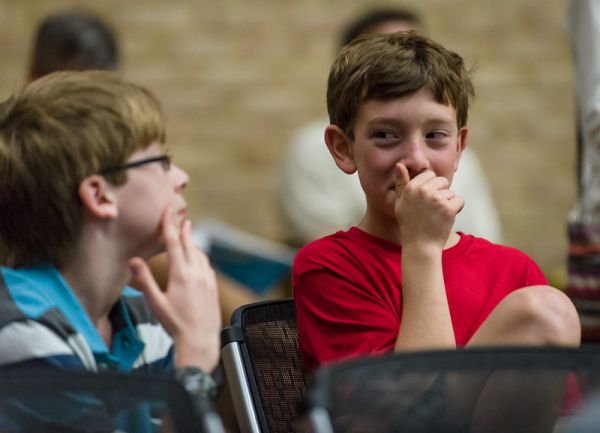| Teachers Share Their Weirdest Fun Facts From Students Posted: 25 Sep 2020 09:29 AM PDT 
Teachers will occasionally ask students to share something about themselves with the class, often in the mode of telling a "fun fact" or maybe in the game "two truths and a lie." The thing about students is that they are young, and sometimes more honest than they should be. Redditor Kriss0509 asked teachers to share those kinds of stories, and the answers will make you laugh or cringe or both. My first year, as an earnest and ideological teacher in a very rough underserved area, I got all the students in a circle on the first day to talk about what we'd done that summer. I pointed to a student who'd been engaged w me before class and said, "what did you do this summer that could inspire us?" His answer: "I did the last 2 months of a sentence for stealing a car."
Um. I hadn't expected that. So I pointed to another student and said, "OK! That's great! Let's talk about what you did this summer!"
That student said, "YES. I had such a good summer. I went to camp and...[laughing] lemme stop lying. I did the last 2 months of a sentence with that guy cause I stole that car w him." -markfromhtx Not a teacher, but on the first day of 9th grade we had to form a circle and say one thing about ourselves that we thought was unique. When it was this dudes turn (lets call him mike) Mike stands up and says in a really serious tone goes '' My mom and dad grow weed''
His house got raided the next day and his dad got arrested smh -RatedRSoopastar
Read the entire reddit thread here, or you can find a ranked list of the 30 best answers at Bored Panda.
(Unrelated image credit: Flickr user Howard County Library System) |
| Super Pigs Do Exist Posted: 25 Sep 2020 09:29 AM PDT 
A wild pig population that's growing at a rapid pace is terrifying experts. Called a "feral swine bomb," these pigs have a population of at least six million and are growing quickly. These super pigs can bear piglets at only three months old! Most of these wild pigs are a mixture of domestic breeds and European wild boar, so they get massive benefits from all that genetic mixture, as Yahoo News details: The wild pig population has "expanded from 17 states to at least 39 over the last three decades" and causes an estimated $2.5 billion in damage a year, The Atlantic said. "I've heard it referred to as a feral swine bomb," said Dale Nolte, manager of the National Feral Swine Damage Management Program at the USDA to The Atlantic. "They multiply so rapidly. To go from a thousand to two thousand, it's not a big deal. But if you've got a million, it doesn't take long to get to 4 [million], then 8 million." Image via Yahoo News |
| What Is Math? Posted: 25 Sep 2020 09:28 AM PDT 
High school student Gracie Cunningham recently went viral with a TikTok video asking about math: how does one define math, is it real, and what is it good for? While some derided her video, mathematicians admit those are profound questions that they themselves struggle with. Is math a science, a part of science, or something on a completely different plane? The comic above illustrates, but does not answer, this conundrum. There are different schools of thought about the nature of math- some consider it a natural thing that we have discovered, while others say it was invented. Some scholars feel very strongly that mathematical truths are "out there," waiting to be discovered—a position known as Platonism. It takes its name from the ancient Greek thinker Plato, who imagined that mathematical truths inhabit a world of their own—not a physical world, but rather a non-physical realm of unchanging perfection; a realm that exists outside of space and time. Roger Penrose, the renowned British mathematical physicist, is a staunch Platonist. In The Emperor's New Mind, he wrote that there appears "to be some profound reality about these mathematical concepts, going quite beyond the mental deliberations of any particular mathematician. It is as though human thought is, instead, being guided towards some external truth—a truth which has a reality of its own..."
Many mathematicians seem to support this view. The things they've discovered over the centuries—that there is no highest prime number; that the square root of two is an irrational number; that the number pi, when expressed as a decimal, goes on forever—seem to be eternal truths, independent of the minds that found them. If we were to one day encounter intelligent aliens from another galaxy, they would not share our language or culture, but, the Platonist would argue, they might very well have made these same mathematical discoveries.
The converse view is empiricism, in which scientists deal with things they can observe. This school of thought regards the idea that "a realm that exists outside of space and time" borders on religion and has no place in science. However, they know that math is useful for scientific observations. And there is disagreement about whether our math would be understood by alien civilizations. Read about the complexity of defining math at Smithsonian.
(Image credit: Randall Munroe at xkcd) |
| <i>Star Wars</i> Opening, <i>Mission Impossible</i> Style Posted: 25 Sep 2020 09:28 AM PDT 
YouTuber Likeonions remixed Star Wars (now known as A New Hope) as a 1960s-style television intro. Specifically, the introduction to the series Mission Impossible. Your mission, should you decide to accept it, is to watch and enjoy the video before it self-destructs. -via Geeks Are Sexy
|
| A Cosmonautics Museum Inside a Church Posted: 25 Sep 2020 08:28 AM PDT
A small but ornately-styled wooden church 80 kilometers from Kyiv is the unlikely home of a museum dedicated to the history of the Soviet space program. Visitors are often surprised when they enter to find they are in Ukraine's Museum of Space Exploration instead of a church. When I first heard about it, I thought it was a genius idea for preserving the old church architecture by finding a new use and a new sponsor for the building. But the reason the museum is there is much more complicated. The church was never actually abandoned, although the museum exhibits have been there since 1979. Journalist Sébastien Gobert explains.
The building is a physical manifestation of the Soviets' attempt to eliminate religion and replace it with space dreams. For now, it looks like the building will remain a museum. Today, the museum's uncertain future reflects the religious tensions in the country, sparked by the Ukrainian Othodox Church's split from the Moscow-based Russian Orthodox Church, one of the biggest schisms in Christian history.
As Gobert explains: "Local church authorities have struggled to have [the museum] back as a church. It has become even more complicated because of the Ukrainian church's feud: the church used to be claimed by the Moscow patriarchate. Now it is claimed by the newly established church of Ukraine. The Moscow patriarchate local priest kind of gave up on his claim provided it does not go to the church of Ukraine. 'Better a museum than schismatics', father Feodossiy said."
Take a look inside the Museum of Space Exploration at The Calvert Journal. -via Nag on the Lake |
| The Saga of Midori Naka Posted: 25 Sep 2020 08:26 AM PDT 
Midori Naka was a popular stage actress in Japan. She and her troupe were in Hiroshima in August of 1945 when the atomic bomb was dropped on the city. Naka was less than a mile from the blast. She survived the explosion, but died 18 days later and was the first person ever whose cause of death was listed as radiation poisoning. Specimens of her tissues were taken during the autopsy, as Japanese, and later American, scientists wanted to understand what the new weapons could do to a human being. These specimens are now in the possession of Hiroshima University's Research Institute for Radiation Biology and Medicine. It might seem obvious that Naka's remains would be in Hiroshima, and in an institution devoted to understanding and treating radiation sickness. But those two glass jars arrived there only by a strange and circuitous route, after having spent decades abroad along with thousands of other body parts, wet specimens, and autopsy materials from the victims of the bombings of Hiroshima and Nagasaki—a unique collection that existed in a medical and political gray area. Like the relics of saints, these body parts took on a strange afterlife: They resonated with invisible power, and their significance changed over time as they were moved through different locations and contexts. Irreplaceable and beyond value, they were coveted, fought over, held up as a singular archive of a world-changing event, and then, gradually, mostly forgotten.
The remains of atomic bomb victims were useful to study, but they were also human remains that had a spiritual tie to their families and to Japan. Read the story of the body parts taken from the first atomic bomb victims at Atlas Obscura.
(Image credit: Delphine Lee for Atlas Obscura) |





No comments:
Post a Comment
Keep a civil tongue.